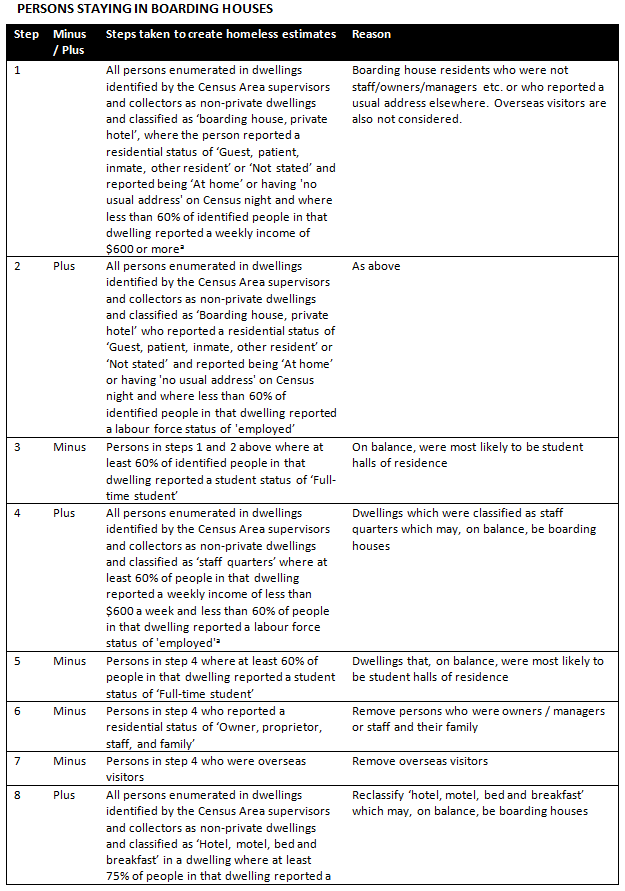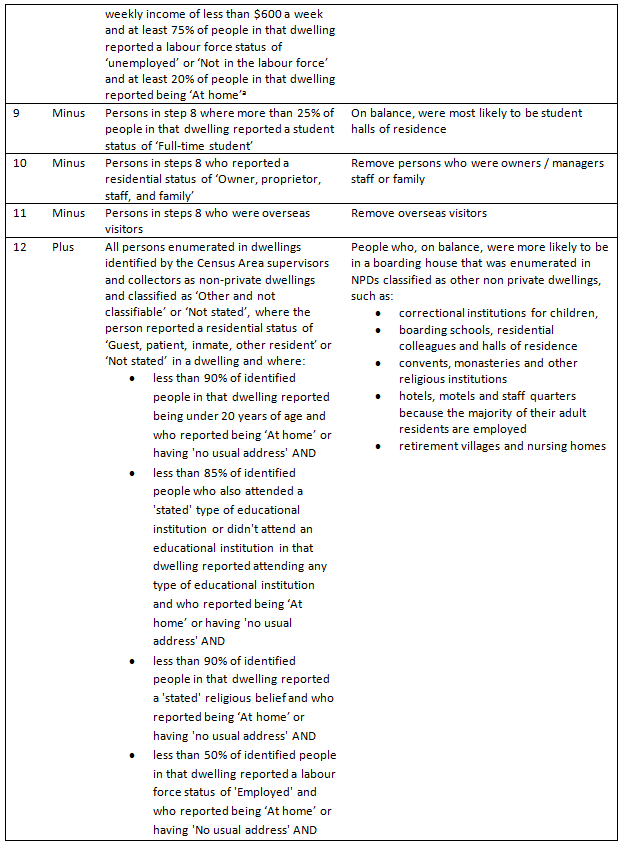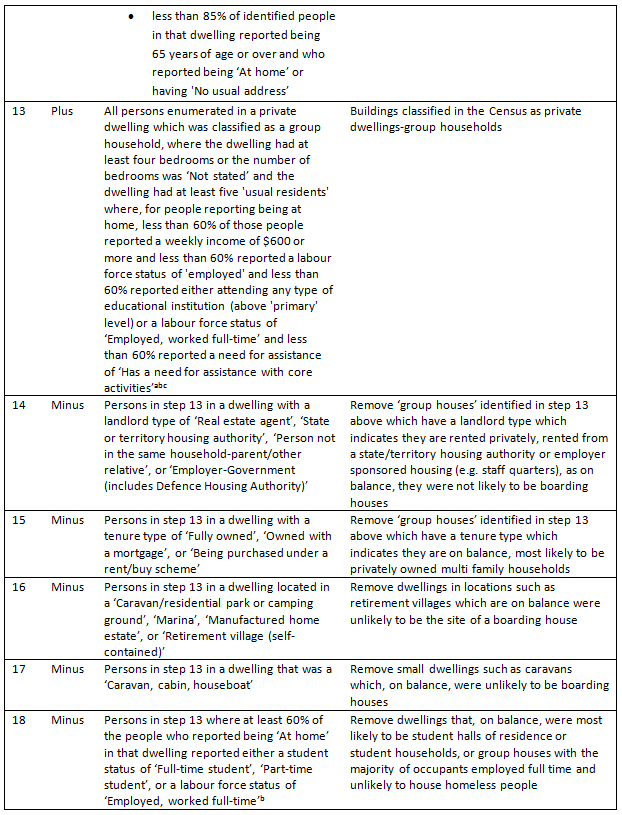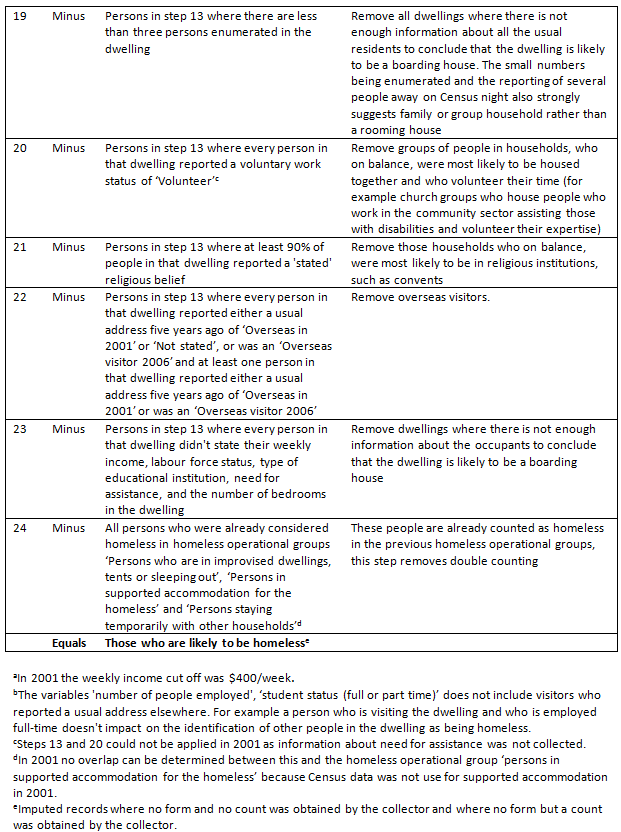PERSONS IN BOARDING HOUSES
The homeless operational group 'Persons in boarding houses' commences with analysis of persons enumerated in non-private dwellings that were classified as 'boarding houses, private hotel'. It is expected that in most cases these boarding houses have been correctly identified as boarding houses by the owner/manager. However, because the boarding house category is not designed to approximate homelessness, it will include some student halls of residence that are not part of any one school but serve multiple schools in a region. Rules are used to exclude those dwellings that, on balance appear to be more likely to be a student hall of residence.
The rules also aim to identify other NPDs that were not classified as boarding houses but where the characteristics of the people in the dwelling suggest that they may be housing large numbers of homeless people and can be assumed, on balance, to more likely to be a boarding house although they were classified by the owner / manager as 'staff quarters', 'hotel, motel, bed and breakfast' or as a dwelling type that was not classifiable, or a classification was not stated.
The rules also attempt to identify any dwellings that were identified by Area Supervisors and Census collectors as private dwellings but the characteristics of the occupants are such that, on balance, it is more likely to be a boarding house rather than a large (apparently) unrelated group household. If a dwelling is private dwelling, but operates illegally on the basis of multiple room by room tenancies, the Area Supervisor and collector may enumerate it according to its legal presentation rather than on the basis of its unobserved operation as a boarding house. The rules are applied to identify these dwelling amongst large (apparently) unrelated group households. However, this method is limited and is likely to overestimate the number of large (apparently) group households as boarding houses due to the limitations of the Census in capturing all relationships in the household. The Census only captures the relationships to the first person on the household form (and child relationships to person 2) so if people in the household are in couple relationship but neither of the couple is reported as person 1, then such households with 5 or more usual residents may be incorrectly classified as group households rather than the family household it really is. That same household may then also be incorrectly assumed to be a boarding house and its residents classified as homeless. The correct classification of households as family households can also be affected when there are persons who were temporarily absent (PTAs) on Census night.
Rules are applied to these large (apparently) unrelated group households to ensure that, on balance, households such as student households, retirement villages, nursing homes, homes for the disabled, convents / monasteries and other religious institutions are not incorrectly reclassified as boarding houses for the homeless.
The same rules for 2001 and 2006 are applied, however for 2006, additional information available from this Census about need for assistance with core activities and volunteering is used to refine the rules to assist with ensuring the best possible reclassification of private dwellings as boarding houses. The aim of using these variables is to remove dwellings that were more likely to be convents or monasteries (and other similar religious institutions) and to remove dwellings more likely to be facilities for the aged. These two items were not collected in the 2001 Census. The rules for 2001 therefore omit these steps which refine the classification of boarding houses.
To determine, on balance, that the dwelling is most likely to have been a boarding house for homeless people, variables such as labour force status, student status, income, tenure type, need for assistance with core activities, religion and volunteering are used. These are shown in more detail in the table below. All of the variables such as income are applied to the individual in private dwellings rather than considering the household income because if they are in boarding houses individuals would not be sharing their economic resources.
In summary, people in boarding houses are assumed to lack 'control of, and access to social relations', and their staying in boarding houses is assumed to reflect the lack of accommodation alternatives that would not be homeless. Note that halls of residence for students, dwellings for members of religious orders and institutions such as hospitals are not boarding houses.
Rules for estimating Persons in boarding houses
The following table presents the rules that are applied to classify persons who were most likely to be homeless on Census night and staying in boarding houses. The rules start with all persons enumerated in dwellings that were classified as 'boarding house, private hotel'. Then additional rules are applied to remove dwellings that are student halls of residences. Rules are applied to 'staff quarters' to pick up any that, on balance, were more likely to be boarding houses. Rules are also applied to 'hotel, motel, bed and breakfast' and 'other and not classifiable' or 'not stated' dwellings to identify if, on balance, they were more likely to be boarding houses. Finally rules are applied to private dwellings which appear to be large unrelated group households, to determine if, on balance, they are more likely to be boarding houses.




 Print Page
Print Page
 Print All
Print All
 Print Page
Print Page
 Print All
Print All